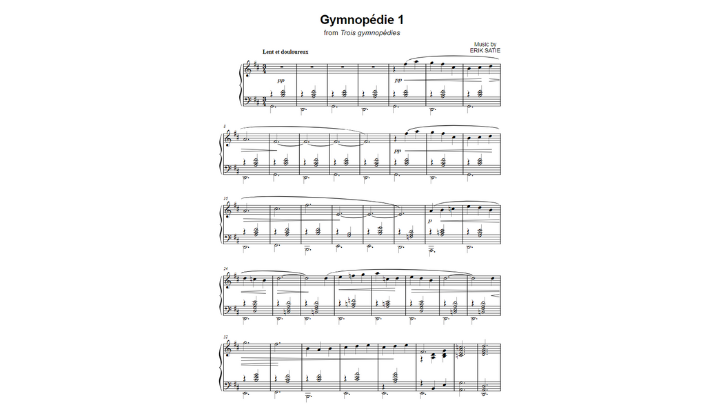6 Methods for Memorizing Music

Memorizing music is an easy task for some and a tiresome task for others. Based on the length and difficulty of a piece, it can take you any given amount of time to memorize. To help you nail down the perfect memorization technique, we’re going to share with you six different methods you can try.
1. Memorize in Small Sections
Possibly the most common way to memorize music is to divide it into small sections. It can be intimidating to tackle an 8-page piece all at once, so memorizing section by section allows for a more focused mindset as well as better retention. The length of sections you choose to tackle is up to you. We recommend looking for phrases.
Phrases are like musical sentances. As a complete musical “thought,” a phrase has a beginning and end.
As you learn how to memorize a song, splitting up a piece by phrases makes sense musically, as opposed to stopping and starting in awkward places in the music. Here’s an example of Erik Satie's “Gymnopédie No. 1” split into phrases. Listen here and follow along in the sheet music.

For particularly difficult sections, you can memorize in even smaller sections, perhaps one to two measures at a time. These phrases will start to stick in your head and become instinctual. Once you’ve mastered a section, remember to keep coming back to it, so that it sticks in your long-term memory and you don’t have to repeat the process later.
2. Start at the End and Work Backward
A widespread technique in memorization is to start at the end of a piece and work back towards the beginning. Similar to splitting up your music in small sections, this technique does the same thing, but in backward chronological order. You can go backward by phrasing or by measure(s). For example, you may start two measures from the end, then start four measures from the end, six, and so on.
Each time you add a new section, continue the piece all the way to the end.
This method is very effective because after you’ve memorized a section, you will continue to perform it over and over again, locking it firmly in place. By the time you’ve reached the beginning, the end will seem like a piece of cake because you will have rehearsed it numerous times.
3. Visualize The Sheet Music
Visualizing sheet music works particularly well for those who have a photographic memory. If you can see the sheet music in your head, you can anticipate what’s next.
As all musicians know, there is far more to memorization than the notes in a piece. You must also memorize dynamics, repeats, tempos, time signatures, codas, lyrics (in the case of vocalists), fingerings (in the case of instrumentalists), expressions, crescendos, and so much more. Visualizing your sheet music applies to each of these things, and can give you quite the advantage when it comes to memorization.
If you don’t have a particularly photographic memory but would like to try this technique, spend some time studying your music without playing or singing. Talk through the music, bringing to attention any tough sections or sudden changes in expression. If you are working to memorize lyrics, consider writing them out. This forces you to concentrate on each individual word. Seeing the words in your own writing can also help you visualize them in your mind later.
4. Memorize at a Slow Tempo
Very rarely do musicians learn a new piece of music at it’s indicated tempo. Starting slow ensures that the notes and rhythms are learned correctly. The same method can be applied to memorization.
It’s very common to begin making mistakes you usually wouldn’t make when starting memorization. Suddenly things you had previously mastered regress, and it’s easy to get frustrated and discouraged quickly. Slowing the tempo down has the same effect as when you’re first learning a piece: it ensures accuracy. It also gives you a fair amount of time to think before playing or singing the next note. As you work your way back to the indicated tempo, you will exercise repetition. Altogether, this method will bypass a lot of the frustration that learning how to memorize music can cause.
5. On and Off Sheet Music
When memorizing a piece of music, it’s easy to “cheat” from time to time. Perhaps your music is in front of you, and you steal a look or two in the difficult sections. At the same time, it can be challenging to put your music completely out of sight. Going back and forth between being “on” book and “off” book is a way of weaning yourself off the sheet music.

Memorizing on and off sheet music entails a run-through your piece (or a section) with the music in front of you, followed by a run-through without it. As you become more confident, you can try a run-through with the music in front of you followed by two run-throughs without the music. Coming back to the music gives you a chance to correct mistakes and find the notes or sections you couldn’t remember without the music. Removing your music completely gives you a chance to try, using your brainpower and your brainpower alone.
For a bit of extra help and accountability, get a partner to practice with you. It is best if that person knows the piece you are studying well and can help you with the nuances. When you are ready to try being off-book but need some back-up, have your partner hold the sheet music while you perform. They can reassure you that you are getting it right, or help you through parts where you may struggle.
6. Beginning to End Repetition
Some musicians don’t like the tedious work of splitting a song up or having a precise method for memorization. And that’s okay! Sometimes what we need is to play or sing the song from beginning to end over and over and over again. The only caution when approaching this method is to make sure you aren’t skipping over any difficult sections or problem areas, and make sure to quickly correct mistakes so you don’t accidentally memorize them. You certainly don’t want to reinforce any bad habits or missed notes after working so hard to learn the piece!
But after you’ve fixed all of the rough patches, playing your piece several times in its entirety is a great way to solidify memorization. As we mentioned before, there is so much more to memorization outside of the notes alone, and this method is perfect for memorizing the ebbs and flows of your piece, as well as the emotion of the song and your performance.
We hope you’re excited to try out a new memorization method! Remember to experiment with different techniques to find the one that works best for you. For more musical tips, check out our “Tips” section!
Frequently Asked Questions
Memorizing music is a tricky thing to master, and comes with a lot of caveats. Here are some of the things people often wonder about.
What Is the Fastest Way To Memorize a Song in Another Language?
Memorizing a song in a language you don’t know can present extra challenges. It becomes harder to break the music into phrases and sections that make sense to you if you are not comfortable with the language or if you don’t completely understand what the song is about. To memorize songs like this, start by looking over the lyrics in their native language. You may spot a few words or phrases that you recognize. Also, get a translation of the song into your language. You can read the entire story of the song, which will help you memorize it by giving you a sort of narrative to follow as you sing.
Repetition is also a great method for learning a foreign song. As you listen and practice, take special notice of the inflections of the lyrics and the melody. This could affect how you say certain words as you perform.
Is it Hard to Learn a Song by Ear?
Learning a song without any sheet music is possible and a common way for many people to learn music. Have you ever learned a song just by listening to the radio? That’s learning a song by ear. How hard or easy it is will depend on what type of learner you are. This method is easier for people who learn well by example and by doing. It will be a bit more challenging for people who like to see and read the material they are trying to learn.
The best way to improve your ability to learn a song by ear is to train your hearing to pick out pitches and notes more accurately. Find a piece of music that you are familiar with and that you know what the notes are. Study how those notes sound, so you can identify them in other situations as well. That way when someone presents a song to you that you will only get to learn by hearing, you have a reference for the notes in your head.

